Stamp: Frank James Marshall (1877-1944) (Western Sahara 1999)
Frank James Marshall (1877-1944) (Western Sahara 1999)
20 September (Western Sahara ) within release Sahrawi Arab Democratic Republic goes into circulation Stamp Frank James Marshall (1877-1944) face value 200 Sahrawi peseta
| Stamp Frank James Marshall (1877-1944) in catalogues | |
|---|---|
| Colnect codes: | Col: SW 1999-08/08 |
Stamp is square format.
Stamps inscribed REPUBLICA SAHARAUI Have been denounced by the Morrocco postal administration as illegal since the year 2000 when they first found out about them being sold on the philatelic market. The circulars are No.129 in 2000, No.414 in 2002, No.69 in 2004 and No.71 in 2008. All illegal stamps inscribed REPUBLICA SAHARAUI were produced and distributed to the philatelic market by illegal stamp producing entities located in the UK and Eastern Europe. There have never been any functioning post offices located in the region under the control of the Sahrawi Arab Democratic Republic at the time the illegal stamps were produced. Stamp from souvenir sheet|
Data entry completed
50%
|
|
|---|---|
| Stamp Frank James Marshall (1877-1944) in digits | |
| Country: | Western Sahara |
| Date: | 1999-09-20 |
| Emission: | Illegal |
| Format: | Stamp |
| Face Value: | 200 Sahrawi peseta |
Stamp Frank James Marshall (1877-1944) it reflects the thematic directions:
Chess is usually played by two players (called chess players) against each other. It is also possible for one group of chess players to play against another or against one player; such games are often called consultation games. In addition, there is the practice of simultaneous play sessions, when several opponents play against one strong player, each on a separate board.
The rules of the game were basically developed by the 15th century; In modern official tournaments, the rules of the International Chess Federation[6] are applied, which regulate not only the movement of pieces, but also the rights of the judge, the rules of behavior of players and time control. A game played remotely - for example, by correspondence, by telephone or via the Internet - has special rules. There are many variants of chess that differ from classical ones: with non-standard rules, pieces, board sizes, etc. The corresponding section of chess composition is fairy chess. Some aspects of the game of chess are studied in mathematics (for example, the classic “Knight's Move Problem” and “Eight Queens Problem”), including through computer simulation. Chess is usually played by two players (called chess players) against each other. It is also possible for one group of chess players to play against another or against one player; such games are often called consultation games. In addition, there is the practice of simultaneous play sessions, when several opponents play against one strong player, each on a separate board.
The rules of the game were basically developed by the 15th century; In modern official tournaments, the rules of the International Chess Federation[6] are applied, which regulate not only the movement of pieces, but also the rights of the judge, the rules of behavior of players and time control. A game played remotely - for example, by correspondence, by telephone or via the Internet - has special rules. There are many variants of chess that differ from classical ones: with non-standard rules, pieces, board sizes, etc. The corresponding section of chess composition is fairy chess. Some aspects of the game of chess are studied in mathematics (for example, the classic “Knight's Move Problem” and “Eight Queens Problem”), including through computer simulation.

